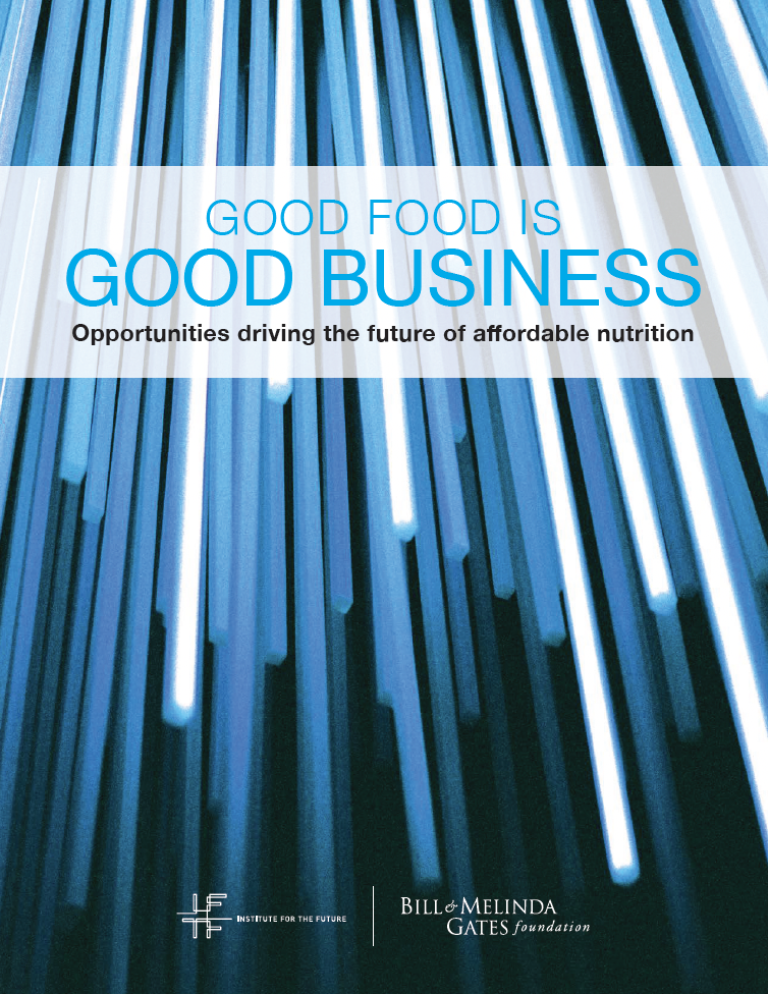Opportunities Driving the Future of Affordable Nutrition
This report, “Good Food Is Good Business,” was developed by the Institute for the Future (IFTF) and commissioned by the Bill & Melinda Gates Foundation. It forecasts the future forces that will drive private-sector business opportunities to create more affordable, accessible, appealing, and nutritious foods for lower-income consumers over the next decade. The report is aimed at four stakeholder groups: national and regional food and beverage companies, multinational food and beverage companies, innovators, and input suppliers to the industry.
In this report, we explore five zones of technological innovation that will spark an affordable nutrition revolution, finally making it possible for food companies to do well and drive market share—while doing good:

AI Collaboration
Toward improved products and better-educated consumers
AI will offer new tools to help multinational and local companies deepen their understanding of consumers’ needs and aspirations. Algorithmic persuasion will also lead consumers in lower-income (and all) markets toward healthier and more economical consumption habits.

Traditional Wisdom
Toward reincorporating time-honored health practices and ingredients
Thousands of years of human intuition about the roles and benefits of food ingredients and preparation techniques will be amplified and reintegrated into new food products. This traditional knowledge will be open, accessible, and actionable by any consumer or producer, anywhere in the world.

Microbiota Management
Toward microbe-friendly diets for optimum health outcomes
The expanding notion of human health—and the interconnected relationship between our diet, well-being, and microbiome—will deepen and open up new opportunities to design food that resists spoilage, tastes better, and targets the nourishment of both bodies and microbes.

Cellular Agriculture
Toward reinventing animal-based products at the cellular level
Advances in the synthetic biology will be applied to food production, enabling the creation of agricultural products through cell cultures that may cheaply and sustainably scale nutritious foods in growing market categories while avoiding the negative environmental impacts of animal agriculture.

Programmable Assets
Toward frictionless transporting and transacting
Food companies will be able to leverage cryptocoupons, smart contracts, and utility tokens managed on blockchains to track food cheaply as it moves from farms to tables. The same systems will optimize organizational functions, enhance food safety at lower costs, and incentivize the consumption of a nutritious food basket.
As synergies between these forces and future opportunities are established, food companies will be able to meaningfully tap into lower-income markets. As you’ll see in this report, it’s good business to create affordable and nutritious food for those who need it.
How to Use This Report:
- Calibrate your understanding of the problems related to affordable nutrition for lower-income consumers.
- Immerse yourself in the opportunity zones and their related forecasts to imagine possibilities for the food system on a ten-year time horizon.
- Explore the insights for affordable nutrition after each opportunity zone to think systematically about how these plausible futures could fundamentally change the landscape of nutritious foods.
- Engage with the design principles presented in the conclusion to experiment with your own ideas for how you could create new innovations for affordable nutrition.

